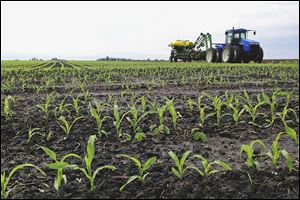
HIGH COMMODITY GAINS
Crop harvest bids well for northwest Ohio, Michigan
6/17/2014
A tractor and planter is parked on a central Illinois cornfield near Chandlerville. Corn growers across the nation’s midsection appear to have finally gotten their crops in the ground after an uncooperative, storm-prone spring left them weeks behind schedule. Seventy-eight percent of Ohio’s corn crop is in good or excellent condition, according to the U.S. Department of Agriculture.
Early into the 2014 growing season, northwest Ohio and southeast Michigan appear well positioned for a solid year and a big harvest.
That’s especially the case for farmers in Defiance and Williams counties in Ohio’s extreme northwest corner. Mike Mock, senior risk manager and grain market global strategist for The Andersons Inc. in Maumee, said the corn crop there looks as good as it does anywhere in the country.
“It just doesn’t get any better,” Mr. Mock said Monday.
Most fields in that region were planted at the opportune time and have avoided driving, damaging rains, giving them an advantage over fields to the east and south of Toledo.
Mr. Mock said that rosy outlook extends on a line along U.S. 24 right through Indiana.
“If you get any kind of July and August weather, you’ve got potential for some really outstanding yields,” he said. “There’s a lot of weather yet to go, but we’re off to a great start here.”
There had been some concerns early in the year that soggy, cool conditions might weigh on the year’s grain crop. But better days were ahead and most farmers caught up.
“After a pretty big scare planting, we’ve actually had pretty decent weather. We’ve seen a lot of fear around the state of the crop decline,” said Matt Roberts, an agricultural economist with Ohio State University.
The U.S. Department of Agriculture said Monday that 78 percent of Ohio’s corn crop is in good or excellent condition. The department said 80 percent of Michigan’s corn crop was in good or excellent condition.
That’s largely the story across the country. The USDA said 75 percent of the United States’ corn crop is in good or excellent condition, compared with 63 percent in the same period a year ago.
Mr. Mock noted areas in southwest Ohio, eastern Ohio approaching the Pennsylvania border, and the northern half of Michigan have been challenged by exceptionally wet conditions this year, but said the area immediately surrounding metro Toledo is doing well.
In Defiance County, Ohio State University extension educator Bruce Clevenger said things are looking exceptional.
“We had sufficient rain following planting, and our corn emerged nicely,” he said. “It continues to develop seemingly more rapidly each day as temperatures rise. Our corn crop is looking very good.”
Mr. Clevenger said continued warm temperatures and some additional showers expected this week should make things even better.
On average, farmers plant about 48,000 acres of corn in Defiance County. Another 100,000 acres are dedicated to soybeans.
“I would expect that number to be near there again if not more. The economics is driving a lot of that. Corn economics compared to soybean economics, soybeans look a little more favorable for 2014.”
Corn prices fell to their lowest level in four months on Monday’s positive crop progress report, which the USDA said was the best in 20 years.
Corn for July delivery fell 6 cents, or 1.3 percent, to $4.41 a bushel, its lowest price since early February. Other agricultural commodities also fell. Wheat fell 5 cents, or 1 percent, to $5.81 a bushel. Soybeans fell 4 cents, or 0.3 percent, to $14.22 a bushel.
Overall, the USDA expects farmers in Ohio to plant a little less corn and a little more soybeans this year. The department anticipates 3.7 million acres of corn planted, down from 3.9 million acres last year. Bean acreage is expected to rise from 4.6 million acres to 4.7 million acres.
That follows the overall U.S. trend. The USDA is forecasting 91.7 million acres of corn to be planted this year. That would be down about 4 percent from last year’s record and the lowest since 2010. Still, it represents the fifth-largest crop in terms of acreage since 1944. The USDA is also projecting a record 13.9 million bushels of corn this year.
Soybean acreage is expected to reach a record 81.5 million acres, up 6 percent from last year.
Experts say early on this year beans appear to have better profit margin potential, which may have enticed some farmers to plant more. Some fluctuation from year to year is also expected as farmers rotate crops.
Contact Tyrel Linkhorn at tlinkhorn@theblade.com or 419-724-6134 or on Twitter @BladeAutoWriter.